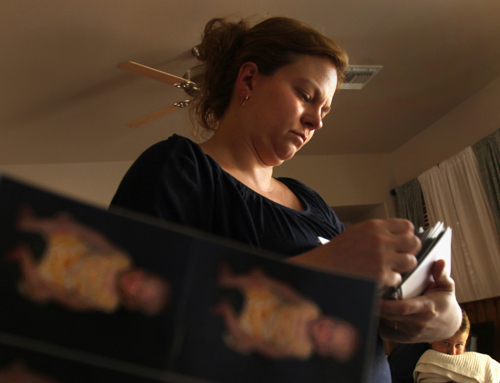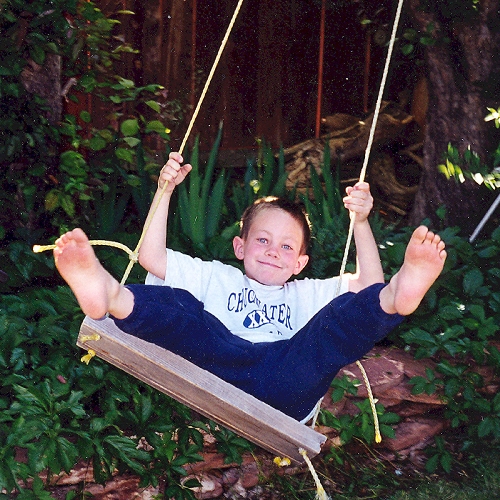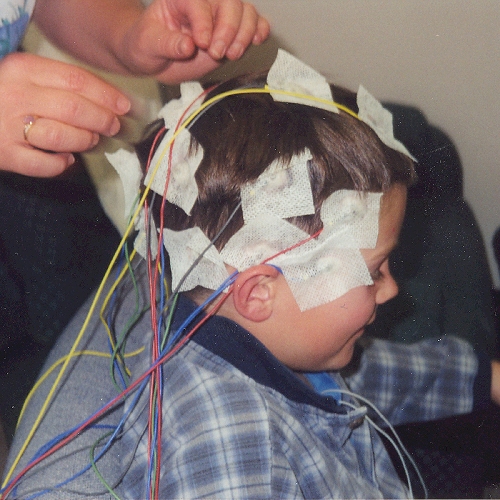Parents promote suicide prevention in wake of son’s death
In the two weeks before 16-year-old Joe Miller killed himself, he seemed to throw off his despair.
He watched his younger brother and sister while his parents were out. He even took his mother out for ice cream three times.
"We got this wonderful kid," father Carl Miller recalled thinking.
His misplaced relief shattered when he found Joe's lifeless body in their master bedroom.
"I can't walk up to his body," Carl told the 911 operator. "I'm a nurse. I'm a nurse. I'm a nurse. He's dead. He's dead. He's dead."
Six different government agencies were on the scene when mother Jennifer Miller came home that June day in 2007.
"I fell to the ground and asked the Lord to let him in," she said.
In light of a recent rash of teen suicides, the Millers are telling Joe's story for the first time, painting it stroke by stroke in painful detail, to provide the complete image of a teen's suicide. A cautionary tale.
"All the warning signs were there," Jennifer Miller said. "We just didn't know."
A SUICIDE SWELL
Joe Miller, a sophomore at Silverado High School, was one of 19 suicides in 2007 among local youths, ranging in age from preteen to 20 years, according to the Clark County Coroner's Office. The number of youth suicides went down in 2008 but has been on the rise every year since. This year, 22 suicides have already been reported for youths, a tally of grief that puts Clark County's youth suicide rate at 2.33 per 100,000 children, almost double the national rate of 1.3.
Over the past few years, more Clark County children are killing themselves, even though fewer local children are dying -- and at a rate below the national average. According to the Nevada Institute for Children's Research and Policy, the national rate of children dying from any cause is 62.4 per 100,000. The rate in Clark County was 60 in 100,000 children in 2008 and dropped to 49 per 100,000 last year.
In addition, the number of students showing suicidal tendencies has also increased considerably, said John Ivers, a counselor who transferred to Silverado the year after Joe's suicide.
He has long one-on-one conversations with students showing suicidal risk because of something they said or did.
"I've already seen three students. There were years when I saw zero," Ivers said.
He asks students very direct questions, following a protocol provided by the Clark County School District. Do you have a plan to commit suicide? Do you have means? Have you given possessions away?
He now has more questions than ever before. Recession questions.
"The moods of the kids have changed, definitely more anxiety," he said of students working to support the family and asking for fewer courses.
The same could be said across the district as children realize they have "less support and feel the pressure," said Rosemary Virtuoso, a leader of the district's Crisis Intervention Team.
Schools call in the team following tragedies. They meet with classmates and assess if anyone else is at risk or having trouble coping.
Crisis response teams are sent to schools for a day or two, at most, following a suicide. But that can't be where the effort stops, said Joe's parents, who both work in district schools and hear word of student suicides.
Those truly at risk often slip through the cracks, Ivers said.
"The ones who do commit suicide don't come in. They've already made up their mind, and no one knows."
He usually sees those wanting help, which is why they alluded to their plans. And that's why Ivers usually doesn't have to prod with his questions. They'll admit it.
In Joe's last two weeks, his mind was made up. He spent the money he saved, drank, and took two girls to the Cheesecake Factory.
"He had a very nice time. It's obvious, now, he made a decision," Carl Miller said. "Did we know that? No."
PAIN FOR GAIN
The Millers recount their son's short life story in an evening. But, as they near the end, all the strings of memories tangle into a messy knot. A knot they've picked and tugged at for four years but will never unravel.
"You can't use the word closure with suicide," Carl Miller said. "You may be able to find some peace."
Looking back, they can't help but notice the signs. Now, they could see it coming.
"After he died, I had to read everything I could get my hands on about suicide, obsessed," said Jennifer Miller, noting that suicide rates go up in the spring, not during the winter in the depths of depression. "When they're feeling better, that's when they have the strength to put their plan into place."
It began with Joe's seemingly unrelated diagnosis at age 5. Epilepsy. They struggled to find an effective medication for his seizures, causing his lips to smack and his eyes to roll backward.
In third grade, a seizure caused him to wet his pants in school.
"He got teased," Jennifer Miller said. "That was devastating for him. That's when it started, his nervousness about people."
SEEING THE SIGNS
The next big blow came in eighth grade when a bully continually harassed him, starting a back and forth that ended with a prank and Joe's expulsion. He went to a behavior school.
The Millers, raising their teenage son and two younger children, were greatly concerned.
"Was Joe a prankster? Yes," Carl Miller said. "Were these typical teenage behaviors? Yes.
"But this whole time, there was an anxiety level building up."
Joe landed in Del Sol High School for freshman year. He was a year older than everyone else but couldn't drive. Epilepsy.
Joe's father now realizes he was always at risk. He had a health problem. It made him stand out in a bad way and struggle.
Feelings of isolation are a key suicide indicator, said Linda Flatt, leader of the Office of Suicide Prevention within Nevada's Department of Health and Human Services. Her experience transcends the professional. Her son committed suicide in 1993.
Eyes need to be open not only to prevent a suicide but following a suicide.
When Virtuoso and her crisis response team walk into a school after a student's suicide, she still looks for signs.
"Essentially, we triage," she said.
Same as doctors assess which patients are in the worst condition and give them aid first, the team individually meets with students to do the same, but look for suicide risk.
"Some students need immediate assistance," Virtuoso said.
They haven't emotionally matured to properly grieve, and doctors' concern is they might do the same, the school psychologist of 37 years said. The crisis teams are part of a department, Student Threat Evaluation and Crisis Response, created within the school district in 2003.
Around that same time, the state started the Office of Suicide Prevention under Flatt's leadership. Virtuoso had noticed something alarming in her group meetings with spouses, parents and siblings of the dead. Many of them were now heading down that same path, becoming "suicidal survivors."
"They tend to go into the same dark place as the one who died," she said, then quoted one of her group members. "It's in the option pool now."
Signs of suicidal risk vary from the obvious -- talking about wanting to die or expressing feelings of unbearable pain -- to the subtle, such as extreme mood swings, sleeping too little or too much, increasing use of alcohol or other drugs, or being reckless and agitated.
"Depression in a teenager looks like normal teenage behavior," Carl Miller said.
PULLING AT THE KNOT
Anxiety dropped into depression that year. Joe realized his lifelong obsession with anything and everything military could never become reality, said his mom, holding Joe's metal ruler with empty bullet shells glued to it like a machine-gun belt.
No military branch would take him.
Epilepsy.
"He still wanted to be in it," Carl Miller said. To stop the seizures, Joe looked into special diets, brain surgery, nerve stimulators. "He did not want to be disabled."
Feelings of hopelessness or having no purpose are a key suicidal indicator.
Then, came the first attempt. Jennifer Miller tries to make sense of it, remembering they argued about Joe's music that she took away.
"He was pissed," she said. "He took a bottle of medicine, immediately got scared and told me."
That night in the hospital was 18 months before the end.
From then on, the family wasn't the same.
"You walked into the house and you're walking on eggshells," Carl Miller said.
THE WEIGHT OF WORDS
The tension is the same in high school counseling offices.
"Everyone's on pins and needles," Ivers said. "There's a fear in the district of misstepping."
Ivers knows that every word he says could have dire consequences. He may be inadvertently pushing them closer to the ledge or pulling them back.
"It's always difficult, draining," he said, then exhaled a deep breath.
Ivers follows up with everyone he sees, even those answering no to his questions. He realizes the weight of his words.
And so did the Millers.
"Yes, we loved these other two kids, but he was our life at that point. He consumed us," Carl Miller said.
They considered moving to the East Coast where Joe could rely on public transportation.
Then, an improvement came. Joe started a bagging job at a Von's grocery store in his sophomore year, and would put most of the money in the bank.
"He was so proud of his parking lot and carts," Jennifer Miller said.
But Joe soon fell a step backward.
His mom noticed a flirty text on Joe's phone from a co-worker. She turned out to be 26 and married with two children. But Joe wouldn't stop the affair.
"It was exciting, new and interesting," Carl Miller said. "He felt old and important as his chances of being a normal adult slipped away."
The family staged an intervention.
"He took those pills the next day," said Jennifer Miller, blankly looking at her feet.
At the time, the Millers didn't know Joe had swallowed a bottle of pills. He called Jennifer from Von's, said he was sick and needed to be picked up.
"He had vomit all over the front of him," she said. "The doctors couldn't figure it out. He was a complete mess in the hospital for four days."
GUNS, HANGINGS AND PILLS
Pills were Joe's method in his two unsuccessful attempts, but it's not the most-used method in successful youth suicides. It's a tie in Clark County between hangings and firearms, accounting for a total of almost nine out of 10 suicides, according to an annual report by the Nevada Institute For Children's Research and Policy.
Pills are the third most popular method. When a gun was used, it almost always belonged to a family member. Joe didn't use a gun, but the Millers didn't have any guns either.
By this time, the 26-year-old woman had been transferred to another store to stop the affair. One night though, her husband called asking for Joe's whereabouts.
The man and his two children came to the Millers' house and waited.
"And Joe walks in," Jennifer Miller said. "That was the end of her, because he had to look that man in the eye. He had to see those little kids come down the stairs."
His father said, "He completely lost his innocence that day, as a human being."
SUICIDE'S LAST CHAPTER
That's when Joe began to act calm and content.
But two weeks before he died, Joe confessed -- during an argument with his mom -- that pills sent him to the hospital for four days.
"That's when my whole world changed," she said.
Two days before his death, one of Joe's teachers visited his mom at work and asked if the school ever called. No.
The teacher told of a day in early May. The class was reading a book about the Holocaust.
She asked the class, "What is the worst thing that could happen to someone?"
Joe raised his hand and said, "The worst thing that could happen is if someone failed at suicide."
Joe met with the counselor later that day but denied any plans, the teacher told her.
She tried to talk to Joe that night, but he refused and left for Boy Scouts.
Two afternoons later, Joe was out early after final exams and at a girl's house when his mom called.
Joe asked his mom when she'd get home. She said same time as always, when work's over.
"He's thinking, 'Summer's coming. I can't get away with this any other time,' " Jennifer Miller said.
He was supposed to stay at the girl's house but left for home in 10 minutes.
"When that phone went down -- click -- 'I'm doing the plan,' " Carl Miller said about his son.
IN A FOG
"For three years, we lived in a fog, just numb. I call it the big, giant mess," she said. Everybody has them. Divorce, death, tragedy.
And they couldn't escape their "prison," their home.
"Our bed was four feet from where he killed himself," Carl Miller said, but they couldn't sell because they were underwater on their home.
After a short sale last summer, they moved. Now that time and space has lifted the fog, they want to prevent the situation from repeating itself.
"It has to be talked about," Carl Miller said. "It can't be all psh-psh-psh whispering."
Flatt, director of the Office of Suicide Prevention, warns against talking too much to teens about a classmate's suicide.
"In the aftermath, it's a delicate balance between safety and support."
Students have to be able to grieve, but schools don't want to allow a memorial stacked high with teddy bears and flowers, she said.
"You don't want others thinking, 'I can get this kind of attention, too,' " she said.
But copycat suicides are "rare," accounting for 1 to 5 percent of all suicides, according to a report by the American Foundation for Suicide Prevention and Suicide Prevention Resource Center.
Students often don't dwell on death, Virtuoso said.
"Students are very resilient," she said. "They react, memorialize and want to move on. We see an evolution."
Jennifer Miller has found that teenagers are "fascinated" by her son's suicide. They want to know what he did, how he did it.
"I don't think it's voyeuristic," she said. "They want to know why. What was he thinking? What was he going through because, 'I've felt like that.' "
Of those teens who follow through with suicide, 70 to 80 percent gave some kind of sign, a call for help, Flatt said.
Contact reporter Trevon Milliard at tmilliard@reviewjournal.com or 702-383-0279.
WARNING SIGNS OF SUICIDE
■ Talking about wanting to die or looking for ways to do it.
■ Talking about feeling isolated, hopeless, trapped, in unbearable pain or hopeless.
■ Talking about being a burden to others.
■ Increasing use of alcohol or drugs.
■ Being anxious, agitated or restless.
■ Sleeping too little or too much.
■ Extreme mood swings.
■ Withdrawing.
WHAT TO DO
■ Do not leave the person alone.
■ Remove any firearms, alcohol, drugs or sharp objects that could be used in suicide.
■ Call the National Suicide Prevention Lifeline at 800-273-TALK.
■ Seek help from a mental health professional.
Source: Nevada Office of Suicide Prevention






























